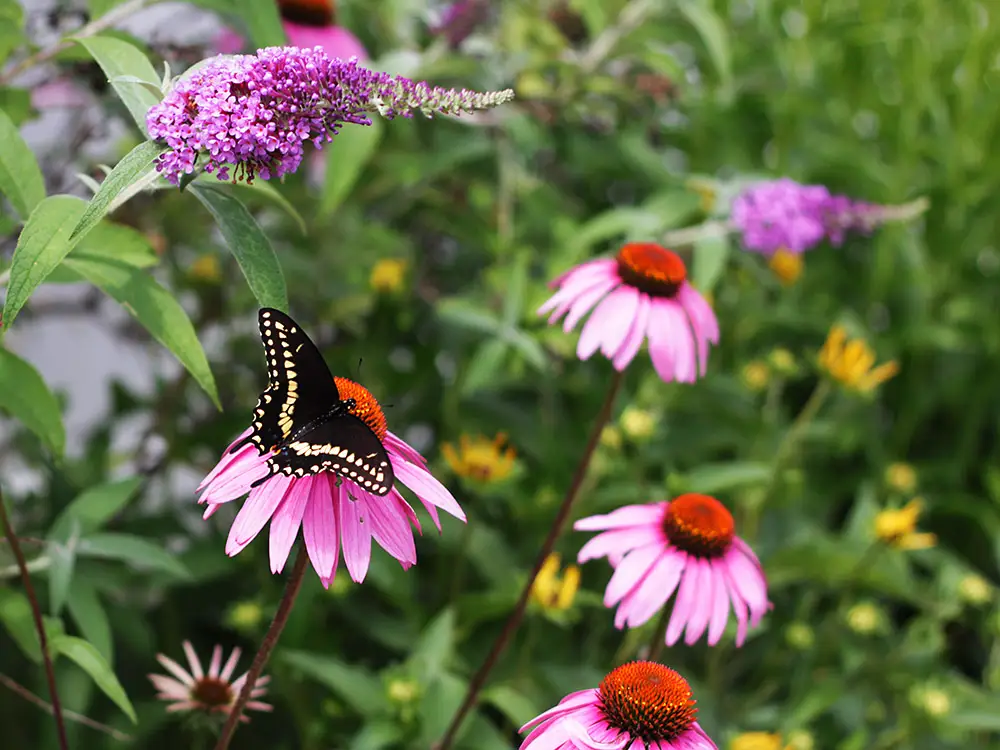Flower Gardening
80 Plants That Attract Pollinators: Your Guide to a Pollinator Party!
If you’ve been searching high and low for the ultimate list of plants that attract pollinators, you’ve come to the right place.
Ever wondered why some gardens are always teeming with butterflies, bees, and hummingbirds, while others seem like barren landscapes? It’s all in the plants! In this article, we’ll dive deep into which plants you should be putting in your garden if you want to become the neighborhood hotspot for pollinators.
Top Plants That Attract Pollinators
So, you’re ready to turn your garden into a bustling hub of pollinator activity, huh? Awesome! Let’s roll up those sleeves and get down to the nitty-gritty. I’m gonna share the inside scoop on the top plants to create a bee friendly garden, or attract butterflies, and bring hummingbirds to your garden.
We’ll dive into what makes each plant a pollinator’s dream, the ideal growing conditions, and which little winged wonders you can expect to see hovering around.
Popular Plants for Pollinators
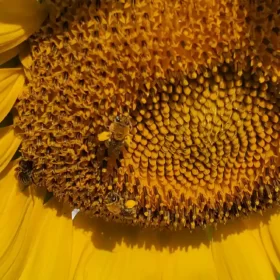
Sunflowers (Helianthus)
Growing Conditions: Full sun, well-drained soil
Pollinators Attracted: Bees, butterflies, birds
Sunflowers are the Times Square for pollinators. And they’re easy to grow; just give them sun and they’re happy as a clam.
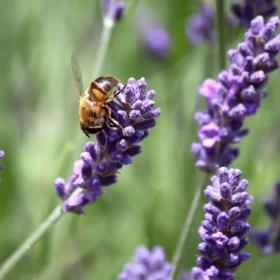
Lavender (Lavandula)
Growing Conditions: Full sun, well-drained soil
Pollinators Attracted: Bees, butterflies
What’s not to love about lavender? It smells good, looks good, and bees go bonkers over it. Trust me, it’s a win-win.

Coneflower (Echinacea)
Growing Conditions: Full sun to partial shade, well-drained soil
Pollinators Attracted: Bees, butterflies, birds
Coneflowers are resilient and will grow in various soil types. They’re like the hardworking, dependable friend everyone needs.
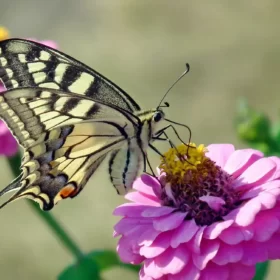
Zinnias (Zinnia elegans)
Growing Conditions: Full sun, well-drained soil
Pollinators Attracted: Butterflies, hummingbirds
These bright and happy flowers are like a neon sign that says, “Hey, butterflies, free nectar here!”

Milkweed (Asclepias)
Growing Conditions: Full sun, dry to medium soil
Pollinators Attracted: Monarch butterflies
If you want to feel like a hero, plant some milkweed. It’s essential for the survival of monarch butterflies, no kidding.
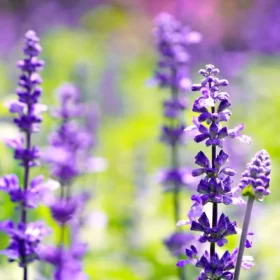
Salvia (Salvia spp.)
Growing Conditions: Full sun, well-drained soil
Pollinators Attracted: Bees, hummingbirds
Hummingbirds can’t resist the tubular flowers of salvia (sage). I had one next to my porch and, let me tell you, the hummingbird traffic was constant!

Foxglove (Digitalis)
Growing Conditions: Partial shade, moist soil
Pollinators Attracted: Bees
Foxgloves are tall and dramatic, and bees love to crawl inside their bell-shaped flowers. Just be cautious; they’re not pet-friendly.
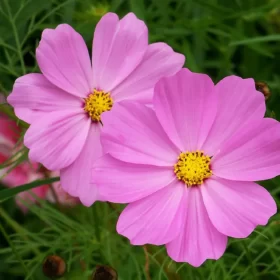
Cosmos (Cosmos bipinnatus)
Growing Conditions: Full sun, well-drained soil
Pollinators Attracted: Bees, butterflies
Cosmos are super easy to grow from seed, and they make your garden look like a Monet painting. Bees and butterflies can’t resist ’em.
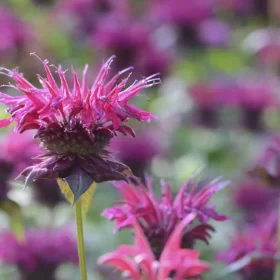
Bee Balm (Monarda)
Growing Conditions: Full sun to partial shade, moist soil
Pollinators Attracted: Bees, hummingbirds
With a name like ‘bee balm,’ you bet it’s a hotspot for bees. But hummingbirds dig it too!
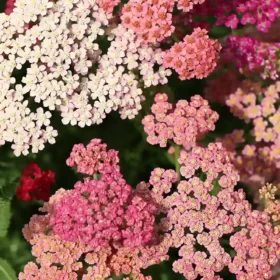
Yarrow (Achillea millefolium)
Growing Conditions: Full sun, well-drained soil
Pollinators Attracted: Bees, butterflies
Yarrow is like the utility player on a baseball team. It’s tough, versatile, and brings in a crowd of pollinators.
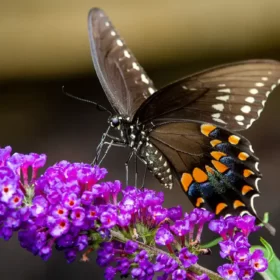
Butterfly Bush (Buddleia)
Growing Conditions: Full sun, well-drained soil
Pollinators Attracted: Butterflies, bees
With a name like ‘Butterfly Bush,’ you can bet your last dollar that this shrub is a butterfly magnet. Seriously, it’s like ringing the dinner bell for winged beauties.

Marigold (Tagetes)
Growing Conditions: Full sun, well-drained to moderately fertile soil
Pollinators Attracted: Bees, some butterflies
These vibrant beauties aren’t just for show; bees love them! Plus, they’re super easy to grow and aren’t picky about soil. Talk about low-maintenance.

Black-Eyed Susan (Rudbeckia hirta)
Growing Conditions: Full sun to partial shade, well-drained soil
Pollinators Attracted: Bees, butterflies
Black-Eyed Susans are the cool kids on the block. Not only are they drop-dead gorgeous, but they’re also like candy stores for bees and butterflies.

Thyme (Thymus)
Growing Conditions: Full sun, well-drained soil
Pollinators Attracted: Bees, occasional butterflies
Not just a kitchen staple, thyme is also a bee-favorite. I once had a herb garden, and let me tell you, the thyme was buzzing with bees!

Lantana (Lantana camara)
Growing Conditions: Full sun, well-drained soil
Pollinators Attracted: Butterflies, bees
Lantana is like a buffet for butterflies and bees. The clusters of tiny flowers offer a full meal deal for our winged friends.

Goldenrod (Solidago)
Growing Conditions: Full sun to partial shade, well-drained soil
Pollinators Attracted: Bees, butterflies
Forget the myth that goldenrod causes allergies (that’s ragweed). This plant is a fall favorite for pollinators, especially bees.
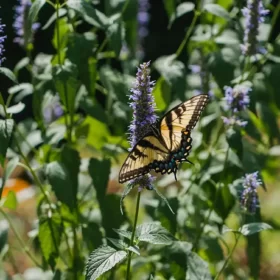
Hyssop (Agastache)
Growing Conditions: Full sun, well-drained soil
Pollinators Attracted: Bees, butterflies
Hyssop offers spiky flowers that are visually stunning and irresistible to pollinators. It’s like the trendy new bar everyone wants to check out.
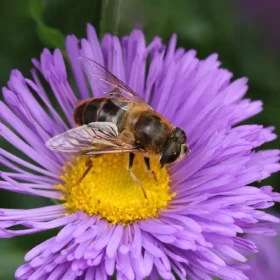
Aster (Aster spp.)
Growing Conditions: Full sun to partial shade, well-drained soil
Pollinators Attracted: Bees, butterflies
Asters provide late-season nectar, making them a crucial pit stop for migrating butterflies and hungry bees.
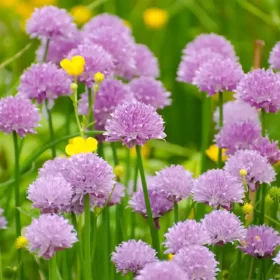
Chives (Allium schoenoprasum)
Growing Conditions: Full sun to partial shade, well-drained soil
Pollinators Attracted: Bees, occasional butterflies
Don’t underestimate these humble kitchen herbs; their purple flowers are a bee hotspot. I had chives in a pot last year, and it was a mini pollinator party!

Trumpet Creeper (Campsis radicans)
Growing Conditions: Full sun, well-drained soil
Pollinators Attracted: Hummingbirds
If you’ve got a place for this vine to climb, the Trumpet Creeper is worth it. Its vivid orange flowers are like a VIP invitation for hummingbirds. NOTE: Can be invasive and difficult to eliminate once established!

Catmint (Nepeta)
Growing Conditions: Full sun to partial shade, well-drained soil
Pollinators Attracted: Bees, butterflies
Catmint is a relative of catnip, and let me tell you, bees seem to find it almost as irresistible as cats do. It’s easy to grow and offers beautiful purple blooms.
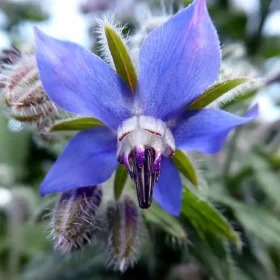
Borage (Borago officinalis)
Growing Conditions: Full sun to partial shade, well-drained soil
Pollinators Attracted: Bees, particularly honeybees
Borage produces star-shaped blue flowers that bees absolutely adore. It’s also super easy to grow, making it a perfect choice for newbie gardeners.
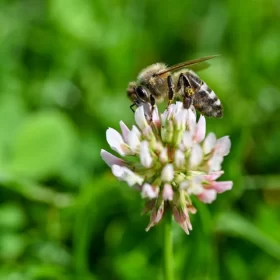
Clover (Trifolium)
Growing Conditions: Full sun to partial shade, adaptable to many soil types
Pollinators Attracted: Bees, butterflies
Clover is not just for good luck; it’s also a magnet for pollinators! Easy to grow, its flowers provide an excellent nectar source for bees and butterflies alike.
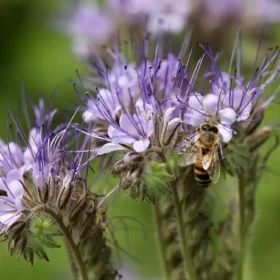
Phacelia (Phacelia tanacetifolia)
Growing Conditions: Full sun, well-drained soil
Pollinators Attracted: Bees, hoverflies
Phacelia is sometimes referred to as “bee’s friend,” and it lives up to its name! Its lavender flowers are rich in nectar and ideal for attracting all sorts of bees.
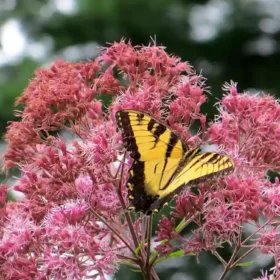
Joe Pye Weed (Eutrochium)
Growing Conditions: Full sun to partial shade, moist soil
Pollinators Attracted: Butterflies, bees
Despite its quirky name, Joe Pye Weed is serious about attracting pollinators. It’s particularly popular with butterflies and can tolerate some shade.

Cardinal Flower (Lobelia cardinalis)
Growing Conditions: Partial shade to full sun, moist soil
Pollinators Attracted: Hummingbirds
With its striking red flowers, the Cardinal Flower is a hummingbird’s dream. It prefers moist soils, making it ideal for woodland gardens or along water features.
And there you have it, the top plants that attract pollinators. Pick your favorites, get planting, and you’ll have a buzzing, fluttering, chirping Eden in no time!
Before you roll up those sleeves, you may want to check out our page about pollinator garden design ideas for some inspiration.
Shade Plants That Attract Pollinators
Alright, let’s talk about those shady areas in your garden. You might think those areas are a lost cause for attracting pollinators, but hold the phone! There are plenty of shade-loving plants or plants that can tolerate some shade that can turn those dim corners into hotspots for bees, butterflies, and the like. So without further ado, let’s dig into some shade-friendly plants that attract pollinators.
Bleeding Heart (Dicentra Spectabilis)
Growing Conditions: Partial to full shade, well-drained soil
Pollinators Attracted: Bees, hummingbirds
Bleeding Hearts are like the drama queens of the garden—in a good way! Their intricate, heart-shaped flowers are a hit with both bees and hummingbirds.
Coral Bells (Heuchera)
Growing Conditions: Partial shade, well-drained soil
Pollinators Attracted: Bees, hummingbirds
These perennials offer delicate flowers and rich foliage. They’re not too fussy and bees and hummingbirds seem to think they’re the bee’s knees.
Hostas (Hosta spp.)
Growing Conditions: Partial to full shade, well-drained soil
Pollinators Attracted: Bees
These leafy beauties are not just for foliage; their trumpet-like flowers are actually quite popular with bees.
Astilbe (Astilbe spp.)
Growing Conditions: Partial shade, moist soil
Pollinators Attracted: Bees, butterflies
Astilbes are like feather dusters of color, and pollinators love them. The plume-like flowers add texture and a pop of color to shady spots.
Lungwort (Pulmonaria)
Growing Conditions: Partial to full shade, well-drained soil
Pollinators Attracted: Bees, butterflies
Don’t let the name put you off—Lungwort attracts a variety of bees and even butterflies, thanks to its tubular flowers.
Columbine (Aquilegia)
Growing Conditions: Partial shade, well-drained soil
Pollinators Attracted: Bees, hummingbirds
These star-shaped flowers are like something out of a fairy tale, and hummingbirds and bees think they’re magical too.
Fern-leaf Bleeding Heart (Dicentra eximia)
Growing Conditions: Partial shade, well-drained soil
Pollinators Attracted: Bees
A cousin to the Bleeding Heart, this one is more understated but still a bee favorite. If you’re a fan of woodland aesthetics, this one’s for you.
Solomon’s Seal (Polygonatum)
Growing Conditions: Partial to full shade, well-drained soil
Pollinators Attracted: Bees
These arching plants are a staple in shade gardens and for a good reason. Their small, tubular flowers are a sweet treat for bees.
Jacob’s Ladder (Polemonium caeruleum)
Growing Conditions: Partial shade, well-drained soil
Pollinators Attracted: Bees, butterflies
This perennial offers clusters of small, bell-shaped flowers that are a hit with bees and butterflies.
Toad Lily (Tricyrtis hirta)
Growing Conditions: Partial to full shade, well-drained, moist soil
Pollinators Attracted: Bees
These exotic-looking flowers might make you do a double-take, and bees find them just as fascinating.
Foxglove (Digitalis purpurea)
Growing Conditions: Partial shade, well-drained soil
Pollinators Attracted: Bees, hummingbirds
These towering beauties are great for shady spots and they are bee magnets. Just remember they’re toxic, so keep your pets away!
Virginia Bluebells (Mertensia virginica)
Growing Conditions: Partial to full shade, moist soil
Pollinators Attracted: Bees, butterflies
These are native to the U.S. and super easy to grow. The trumpet-shaped flowers are a bee and butterfly favorite.
Wild Geranium (Geranium maculatum)
Growing Conditions: Partial shade, well-drained soil
Pollinators Attracted: Bees
These aren’t your grandma’s geraniums. Wild geraniums are more subtle but still attract a respectable bee crowd.
Hellebore (Helleborus)
Growing Conditions: Partial to full shade, well-drained soil
Pollinators Attracted: Bees
Hellebores are one of the first to bloom in spring, offering early sustenance for bees. Their nodding flowers are like ringing the breakfast bell for pollinators.
Anemone (Anemone spp.)
Growing Conditions: Partial shade, well-drained soil
Pollinators Attracted: Bees, butterflies
Also known as windflowers, these come in a range of colors and types. Their simple, yet striking flowers are a hit with both bees and butterflies.
Monkshood (Aconitum)
Growing Conditions: Partial shade, well-drained soil
Pollinators Attracted: Bees
Note: Monkshood is toxic to humans and animals but does attract bees. So if you have little ones or fur babies, you might want to skip this one.
Campanula (Campanula spp.)
Growing Conditions: Partial shade, well-drained soil
Pollinators Attracted: Bees, butterflies
Also known as bellflowers, their bell-shaped blooms are like a homing beacon for bees and butterflies.
Sweet Woodruff (Galium odoratum)
Growing Conditions: Partial to full shade, well-drained soil
Pollinators Attracted: Bees
This ground cover has tiny white flowers and a sweet smell. Bees seem to love it, making it an attractive option for shady areas.
Even in the shadiest corners of your garden, you can roll out the welcome mat for pollinators. Who says shade can’t be exciting?
Ornamental Plants That Attract Pollinators
If you want to add a little pizzazz to your garden while still rolling out the red carpet for our pollinator pals, you’re in the right place. Ornamental plants can do double-duty, looking gorgeous while also offering nectar and pollen. Let’s dive into some ornamentals that aren’t just pretty faces, they’re also plants that attract pollinators.
Hibiscus (Hibiscus spp.)
Growing Conditions: Full sun to partial shade, well-drained soil
Pollinators Attracted: Hummingbirds, butterflies
Hibiscus flowers are like the supermodels of the plant world—big, bold, and absolutely stunning. And guess what? Hummingbirds and butterflies are totally smitten.
Dahlia (Dahlia spp.)
Growing Conditions: Full sun, well-drained soil
Pollinators Attracted: Bees, butterflies
Dahlias offer variety in spades. From pom-pom types to the dinner-plate-sized blooms, they’re a feast for our eyes—and a literal feast for bees and butterflies.
Fuchsia (Fuchsia spp.)
Growing Conditions: Partial shade, moist soil
Pollinators Attracted: Hummingbirds
These exotic stunners are hummingbird magnets. Their dangling, tubular flowers are like a VIP lounge for our feathery friends.
Japanese Maple (Acer palmatum)
Growing Conditions: Full sun to partial shade, well-drained soil
Pollinators Attracted: Bees
Yes, trees can be ornamental too! The Japanese Maple is known for its striking leaves, but its flowers are bee-friendly.
Ornamental Allium (Allium spp.)
Growing Conditions: Full sun, well-drained soil
Pollinators Attracted: Bees, butterflies
You might know alliums as onions and garlic, but some varieties are grown purely for their ornamental value. The round, globe-like flowers are bee and butterfly hotspots.
Nasturtium (Tropaeolum majus)
Growing Conditions: Full sun to partial shade, well-drained soil
Pollinators Attracted: Bees, butterflies
Nasturtiums have vibrant flowers and rounded leaves, adding an instant pop of color. Bees and butterflies can’t resist their peppery allure.
Dusty Miller (Senecio cineraria)
Growing Conditions: Full sun, well-drained soil
Pollinators Attracted: Bees
Okay, this one’s more about the foliage, but those silvery leaves are an eye-catcher. And while they’re turning heads, they’re also beckoning bees to their yellow flowers.
Penstemon (Penstemon spp.)
Growing Conditions: Full sun, well-drained soil
Pollinators Attracted: Hummingbirds, bees
These spiky flowers are a hummingbird’s dream. Their tubular shape is perfect for long beaks, and bees dig them too.
Growing Conditions: Full sun, well-drained soil
Pollinators Attracted: Bees, butterflies
Echinacea (Coneflower)
Sure, echinacea is a native plant and medicinal herb, but it’s also ornamental. Its daisy-like flowers are a magnet for bees and butterflies.
Daylily (Hemerocallis)
Growing Conditions: Full sun to partial shade, well-drained soil
Pollinators Attracted: Bees, butterflies
Daylilies come in a plethora of colors and they’re pretty low maintenance. And guess what? The pollinators love ’em as much as gardeners do.
Red Hot Poker (Kniphofia)
Growing Conditions: Full sun, well-drained soil
Pollinators Attracted: Hummingbirds, bees
These plants are aptly named—they’re fiery in color and striking in appearance. Hummingbirds especially can’t seem to resist their unique, tubular blooms.
Zinnia (Zinnia spp.)
Growing Conditions: Full sun, well-drained soil
Pollinators Attracted: Butterflies, bees
Zinnias are like the jack-of-all-trades in the flower world. Easy to grow from seed and available in a ton of colors, they’re a butterfly and bee favorite.
Coral Honeysuckle (Lonicera sempervirens)
Growing Conditions: Full sun to partial shade, well-drained soil
Pollinators Attracted: Hummingbirds, bees
Not to be confused with its invasive cousin, Japanese honeysuckle, this native variety is great for trellises and attracts both hummingbirds and bees.
Flowering Tobacco (Nicotiana alata)
Growing Conditions: Full sun to partial shade, well-drained soil
Pollinators Attracted: Hummingbirds, moths
These come in a variety of colors and their trumpet-shaped flowers are ideal for hummingbirds and moths. They also emit a sweet scent, especially in the evening.
Snapdragon (Antirrhinum majus)
Growing Conditions: Full sun, well-drained soil
Pollinators Attracted: Bees, butterflies
Snapdragons have a unique flower shape that bees and butterflies find intriguing. Plus, kids (and let’s be honest, adults too) love snapping their dragon-like blooms!
Agastache (Agastache spp.)
Growing Conditions: Full sun, well-drained soil
Pollinators Attracted: Bees, butterflies, hummingbirds
Also known as hyssop, these plants have aromatic foliage and spiky flowers that are beloved by a range of pollinators.
Globe Thistle (Echinops ritro)
Growing Conditions: Full sun, well-drained soil
Pollinators Attracted: Bees, butterflies
These are like little globe-shaped beacons for pollinators. Their spiky, spherical blooms are something to behold and offer a different shape for the garden and a landing pad for pollinators.
Yarrow (Achillea millefolium)
Growing Conditions: Full sun, well-drained soil
Pollinators Attracted: Bees, butterflies
While yarrow is often celebrated for its medicinal properties, its flat, umbrella-like clusters of flowers are also a big hit with pollinators.
These ornamental plants prove that you don’t have to choose between a beautiful garden and a functional one. You can have it all: color, texture, and a flurry of wings!
Container Plants That Attract Pollinators
Alright, don’t have a ton of yard space? No worries! Even if you’ve got just a patio, balcony, or even a sunny windowsill, you can still join the pollinator party. Container gardening is like the tiny house movement for plants, it’s all about making the most of what you’ve got. And yes, there are plenty of container plants that attract pollinators, too!
Lavender (Lavandula spp.)
Growing Conditions: Full sun, well-drained soil
Pollinators Attracted: Bees, butterflies
Lavender is like the little black dress of the plant world—it’s timeless and works for almost any occasion. Bees and butterflies go nuts for its purple blooms, and it grows well in pots.
Mint (Mentha spp.)
Growing Conditions: Full sun to partial shade, moist soil
Pollinators Attracted: Bees
Trust me, if you don’t want mint taking over your garden, a container is the way to go. It’s great for bees and makes your iced tea taste divine.
Calibrachoa (Calibrachoa spp.)
Growing Conditions: Full sun, well-drained soil
Pollinators Attracted: Bees, butterflies
These are like mini petunias and are great for hanging baskets. Bees and butterflies find their trumpet-shaped flowers irresistible.
Thyme (Thymus vulgaris)
Growing Conditions: Full sun, well-drained soil
Pollinators Attracted: Bees
When thyme flowers, it becomes a bee hotspot. It’s low-maintenance and can easily be grown in a small pot.
Cosmos (Cosmos spp.)
Growing Conditions: Full sun, well-drained soil
Pollinators Attracted: Bees, butterflies
These are tall and showy, so use a large container. The blooms come in many colors, and bees and butterflies love them.
Sweet Alyssum (Lobularia maritima)
Growing Conditions: Full sun to partial shade, well-drained soil
Pollinators Attracted: Bees, butterflies
This plant is low-growing and excellent for the front of your container garden. The tiny white flowers are super fragrant and attract a variety of pollinators.
Basil (Ocimum basilicum)
Growing Conditions: Full sun, well-drained soil
Pollinators Attracted: Bees
Let a few of your basil plants flower, and you’ll see bees buzzing around them. Plus, you’ll have fresh herbs at your fingertips!
Salvia (Salvia spp.)
Growing Conditions: Full sun, well-drained soil
Pollinators Attracted: Bees, hummingbirds
Salvia comes in several varieties and colors. Its spiky flowers are a favorite among hummingbirds.
Marigold (Tagetes spp.)
Growing Conditions: Full sun, well-drained soil
Pollinators Attracted: Bees, butterflies
Marigolds are easy to grow in containers and offer bright, cheerful colors. They’re also a hit with bees and butterflies.
Petunia (Petunia spp.)
Growing Conditions: Full sun, well-drained soil
Pollinators Attracted: Bees, butterflies, moths
Petunias are another versatile container plant that offers tubular flowers for pollinators. They’re also available in many different colors and patterns.
Pansy (Viola x wittrockiana)
Growing Conditions: Partial sun, well-drained soil
Pollinators Attracted: Bees, butterflies
Pansies are like the smiling faces of the plant world. They offer a pop of color and are a big hit with bees and butterflies.
Snapdragon (Antirrhinum majus)
Growing Conditions: Full sun to partial shade, well-drained soil
Pollinators Attracted: Bees, butterflies
Yes, they made another appearance! Snapdragons work great in containers, too, and are loved by bees and butterflies for their intriguing shape.
Geranium (Pelargonium spp.)
Growing Conditions: Full sun, well-drained soil
Pollinators Attracted: Bees
Geraniums are hardy and versatile. The classic red ones are especially great at attracting bees.
Lemon Balm (Melissa officinalis)
Growing Conditions: Full sun to partial shade, well-drained soil
Pollinators Attracted: Bees
This plant not only smells amazing but is also a favorite of bees. Lemon balm can be a bit invasive, so containing it in a pot is a wise choice.
Verbena (Verbena spp.)
Growing Conditions: Full sun, well-drained soil
Pollinators Attracted: Bees, butterflies
Verbena offers clusters of small flowers and can be an excellent trailing plant for containers. It’s popular with both bees and butterflies.
Impatiens (Impatiens walleriana)
Growing Conditions: Partial to full shade, well-drained soil
Pollinators Attracted: Bees
Perfect for shady spots, impatiens provide a burst of color and are good for attracting bees.
Chives (Allium schoenoprasum)
Growing Conditions: Full sun to partial shade, well-drained soil
Pollinators Attracted: Bees, butterflies
When chives bloom, their tiny purple flowers are a magnet for bees and butterflies. Plus, you can snip some for your cooking!
Rosemary (Rosmarinus officinalis)
Growing Conditions: Full sun, well-drained soil
Pollinators Attracted: Bees
Rosemary is not only a culinary gem but also a bee-friendly plant when it blooms.
Torenia (Torenia spp.)
Growing Conditions: Partial shade, well-drained soil
Pollinators Attracted: Bees, hummingbirds
Also known as wishbone flower, Torenia is excellent for shady areas and is visited by both bees and hummingbirds.
Even if you’re limited on space you can grow these container plants that attract pollinators right on a patio or balcony. The more you diversify your containers, the more you’ll see a range of pollinators visiting.
Plant Combinations for a Diverse Pollinator Garden
When it comes to attracting a varied group of pollinators, think of your garden like a playlist. You wouldn’t stick to just one genre of music, right? Same goes for plants. Mixing it up can keep things interesting and attractive for everyone, from bees to birds and butterflies.
Layering Heights: From Ground Cover to Tree Canopy
Ground covers like clover and creeping thyme can serve as the garden’s “bass line,” offering easy access for smaller pollinators. Moving upwards, think about adding some mid-height performers like lavender and salvia. And don’t forget the tree canopy! Trees like the tulip poplar can provide food for larger-winged visitors like the swallowtail butterfly.
By using plants of varying heights, you’re not just making your garden more visually appealing; you’re maximizing the amount of real estate available for pollinators. It’s like opening up both a ground floor and a rooftop bar at your garden club!
Flower Shapes: Catering to Different Pollinators
Different pollinators are attracted to different shapes of flowers. For example, bees love open, daisy-like flowers, while hummingbirds are drawn to tubular shapes like those of trumpet creepers.
Incorporate a range of flower shapes into your garden to ensure that you’re catering to a diverse crowd. If your garden were a party, you’d want snacks for everyone, right?
Seasonal Succession: A Year-Round Buffet
Nobody likes a one-hit-wonder, and your garden shouldn’t be one, either. Aim to have something blooming in each season. Spring bulbs like crocuses, summer beauties like sunflowers, and fall stars like asters can keep the party going all year long.
Keep track of bloom times when you’re picking your plants, and shoot for a seamless succession. This way, your pollinator friends won’t ever have to suffer through a food shortage. For more information, check out our page about seasonal considerations for pollinator gardens.
Color Spectrum: A Visual Feast
Different pollinators are attracted to different colors. Bees prefer blue, purple, and yellow, while hummingbirds are crazy about red.
Don’t be shy; fill your garden with a spectrum of colors. This will not only make your space more aesthetically pleasing but also make it a popular spot for a variety of pollinators.
Fragrance and Flavor: More Than Just Visual Appeal
Sometimes, a flower’s fragrance can be just as appealing to pollinators as its visual allure. Plants like jasmine or lilacs can fill the air with scents that are irresistible to bees and butterflies.
And let’s not forget herbs! Many herbs like basil, mint, and rosemary provide both scent and flavor that can be tantalizing for pollinators. Plus, you get the bonus of fresh herbs for your kitchen!
Caring for Your Pollinator Plants
Okay, so you’ve rolled up your sleeves, donned your gardening gloves, and planted a veritable buffet of plants that attract pollinators. High five! But, wait up, a thriving garden doesn’t just happen.
These plants, as independent as they may seem, do need some TLC to give their best performance. Let’s dig into some care tips that’ll keep your plants, and their pollinator groupies, happy.
Watering Wisely
Consistency is Key
A consistent watering schedule is key, especially for container plants that dry out quicker. But, avoid overwatering as this can lead to root rot.
Some plants prefer their soil to be consistently moist, while others like to dry out a bit between waterings. Stick your finger about an inch into the soil; if it feels dry, it’s time for a drink.
Fertilizing: Less Is Often More
Some plants that attract pollinators, like lavender, actually like poor soil and don’t need much fertilization. Others might appreciate a little nutrient boost. Always read up on each plant’s specific needs.
Go for organic fertilizers when you can. These are less likely to harm the pollinators visiting your garden.
Pruning and Deadheading
Pruning helps many plants produce more flowers, which in turn attract more pollinators. Deadheading, or removing spent blooms, also encourages more flowering.
Timing is crucial when it comes to pruning. Some plants prefer a springtime snip, while others are best pruned in the fall.
Pesticides: Just Say No
If you’re aiming to attract pollinators, you’ve got to make sure you’re not simultaneously poisoning them. Ditch the chemical pesticides and look for more natural pest control methods, like introducing ladybugs or using neem oil.
If you absolutely must use pesticides, opt for spot treatment rather than spraying your entire garden with harmful chemicals. Or better yet, learn to use pollinator friendly pest control methods.
Keeping the Buzz Alive
To keep pollinators coming back, aim for a variety of plants that flower at different times. This way, there’s always something in bloom.
A layer of mulch can help conserve moisture and suppress weeds. But avoid piling it too high around the base of your plants, as this can cause rot.
Conclusion
Creating a pollinator-friendly garden is a rewarding endeavor that brings life, color, and vibrancy to your outdoor space. By incorporating a variety of plants that attract different types of pollinators, you’re not only creating a visually appealing garden but also contributing to local ecosystems and biodiversity.
Understanding the importance of pollinators is crucial for any gardener. Whether you have a sprawling garden or just a tiny balcony, you can make your space a haven for pollinators. And when your garden is buzzing, you’ll know you’ve done your bit for the circle of life.
So go ahead, dig in and let your garden buzz, flutter, and hum with life!


